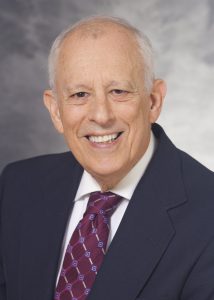Paul Kaufman, MD
Credentials: Professor Emeritus
Position title: Ernst H. Bárány Professor of Ocular Pharmacology, Department Chair Emeritus
Email: paul.kaufman@wisc.edu

Affiliate Appointment
Wisconsin National Primate Research Center, Animal Health and Biomedical Sciences – School of Veterinary Medicine
Subspecialty
- Glaucoma
- Aqueous humor dynamics
- Anterior segment physiology and pharmacology
- Presbyopia
Research Interests
- Glaucoma, accommodation/presbyopia, intraocular pressure regulation/aqueous humor dynamics
- Devise methods for obtaining accurate, reproducible measurements of Schlemm’s canal pressure as the gateway to the distal aqueous outflow apparatus
- Develop gene therapies to enhance aqueous humor outflow and reduce intraocular pressure
- Study the anatomic and pathophysiological relationship between presbyopia and glaucomatous optic neuropathy
- Characterize all anatomical movements during accommodation (i.e., ciliary muscle, lens, sclera, choroid, vitreous fluid, vitreous membranes/fibers/strands) and their changes with age
- Elucidate the full mechanism of accommodation and the extralenticular pathophysiology of presbyopia
Dr. Kaufman’s research centers on studies of the physiology, pharmacology, morphology, cell biology, genetic manipulation, neural control, biomechanics and aging of the aqueous humor formation and drainage and accommodative mechanisms in the non-human primate, seeking to understand the pathophysiology and develop new therapies for the human diseases of glaucoma and presbyopia.
Glaucoma is the second most common cause of irreversible visual loss in adult Americans, the most common among African Americans, and the most common world-wide, while presbyopia is the most common of all ocular afflictions.
Research Highlights
Dr. Paul Kaufman has been producing groundbreaking research for almost fifty years that has not only elucidated many of the mechanisms that contribute to glaucoma, but also his research has advanced treatments available for patients suffering from this condition. Four highlights of Dr. Kaufman’s prestigious career include:
- Mechanisms of IOP regulation and the pathophysiology of glaucoma. Dr. Kaufman’s non-human primate research elucidated the role of Rho kinase (RK) and nitric oxide (NO) in the outflow of fluid from the trabecular meshwork. These formative studies contributed to the exploration of RK inhibitors and NO-donating compounds in clinical trials resulting in treatments for glaucoma that are now under phase 3 clinical evaluation.
- Facilitated the development of Prostaglandin F2α, PGF2α analogues into the most commonly prescribed topical glaucoma medication world-wide. PGF2α was a known potent ocular hypotensive agent in primates and in man, but their mechanism of action was unknown. With Dr. Kaufman’s leadership, PGF2α signals were discovered remodeling the extracellular matrix in the ciliary muscle of the eye, thus reducing resistance to fluid outflow and protecting the eye from severe ocular hypertension. The work led directly to the introduction of the prostaglandin agonists for glaucoma (latanoprost [Xalatan]).
- Exploration of new approaches of both lentviral and adenoviral mediated gene transfer to the trabecular meshwork and Schlemm’s canal. The targets of these therapies affected fluid outflow in non-human primates and could lead to a long-term reduction of IOP, therefore being a viable new therapeutic approach for glaucomatous conditions.
- Structural mechanism of presbyopia research. Presbyopia is the world’s most common ocular affliction and it was thought that age-related loss of lenticular deformability was long regarded as the cause of this condition. As a result, accommodating intraocular lenses (AIOLs) were designed with the assumption that the ciliary muscle and zonular movements necessary for lens movement and deformation are equal to those in the young eye. However, Dr. Kaufman has shown that ciliary muscle mobility is restricted by progressively inelastic posterior attachments. His lab’s structural findings have been confirmed by in vivo imaging and may explain the poor performance and limited accommodative amplitude provided by current AIOLs. AIOL designs are now beginning to take reduced mobility into account and incorporating compensatory strategies.
Collectively, Dr. Kaufman’s publications from 1976-2020 have been cited an astounding 7,040+ times (Scopus) or 14,455+ (Semantic Scholar).
Effect of nitric oxide on anterior segment physiology in monkeys
Collagen type I is reduced in the ciliary muscle of inflamed monkey eyes
Prospects for lentiviral vector mediated prostaglandin F synthase gene delivery in monkey eyes in vivo
Presbyopia and glaucoma: two diseases, one pathophysiology
He has supported various U.S. and foreign-based scholars resulting in thousands of collaborative publications. Of those publications, seven foreign scholars contributed from countries including China, Canada, Germany, South Korea and Turkey.
Application of canaloplasty in glaucoma gene therapy. Where are we?
Proteasome inhibition increases the efficiency of lentiviral vector-mediated transduction of trabecular meshwork
Effect of latrunculin B on IOP in the monkey eye
Effect of PGF synthase transgene expression on intraocular pressure in monkey eyes in vivo
Effect of cochlin transgene expression by adenovirus on cultured human trabecular meshwork cells and outflow facility in organ cultured anterior segments
Topical PGF2 increases uveoscleral outflow in the rabbit eye
Mitomycin C suppresses aqueous humor flow in Cynomolgus monkeys
Retinal blood flow after superior cervical ganglionectomy: a laser Doppler study in the cynomolgus monkey
Intraocular pressure measurement after penetrating keratoplasty: minified Goldmann applanation tonometer, pneumatonometer, and Tono-Pen versus manometry
The effects of C3 transgene expression on actin and cellular adhesions in cultured human trabecular meshwork cells and on outflow facility in organ cultured monkey eyes
Education
Fellowship: Seeing Eye and National Institutes of Health Research Fellow, Departments of Pharmacology and Physiology, University of Uppsala, Uppsala, Sweden
Residency: Washington University School of Medicine and Barnes Hospital, St. Louis, MO
Internship: Bellevue Hospital, Columbia University Medical Division, New York, NY
Medical School: New York University School of Medicine, New York, NY